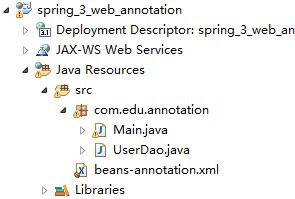Spring学习之旅(四)Spring工作原理再探
上篇博文对Spring的工作原理做了个大概的介绍,想看的同学请出门左转。今天详细说几点。
(一)Spring IoC容器及其实例化与使用
Spring IoC容器负责Bean的实例化、配置和组装工作有两个接口:BeanFactory和ApplicationContext。其中ApplicationContext继承于BeanFactory,对企业级应用开发提供了更多的支持。在实际应用中都是用该接口。
1)实例化Spring容器(主要有四种)
1.ClassPathXmlApplicationContext: 在类路径下寻找配置XML文件实例化容器。
ApplicationContext act = new ClassPathXmlApplicationContext("hellobean.xml");
2.FileSystemXmlApplicationContext:在文件系统路径下寻找配置文件来实例化容器。
ApplicationContext act=new FileSystemXmlApplicationContext("d:/beans.xml");
3.XmlWebApplicationContext:从Web应用目录WEB-INF中的XML配置文件实例化容器。(小编未能实现成功,请实现成功的同学指教)
WebApplicationContext wctx = new XmlWebApplicationContext();
4.在web.xml配置文件中,通过配置监听器实例化容器。(假定已经配置了Spring的配置文件)
在web.xml中注册Spring提供的Servlet监视器,它会在当前Web应用被加载时将Spring的ApplicationContext保存到ServletContext对象中。
Spring配置文件可指定多个,之间用逗号隔开。
//在网页中通过request对象或其他方式,获取Web服务器容器
ServletContext sc=request.getServletContext();
//利用spring框架提供的静态方法,从Web服务器中获取Spring容器
WebApplicationContext wact=WebApplicationContextUtils.getRequiredWebApplicationContext(sc);
2)生成Bean实例
Spring容器通过getBean()方法,从容器中获取所管理的对象。
例如:
HelloBeans student=(HelloBeans)wctx.getBean("stu1");
(二)基于XML文件方式的Bean配置
在java容器中形成Bean称为装配。
Bean的装配形式有两种:基于XML文件的方式和基于注解的方式。
基于XML文件的方式就是用一个XML文件对Bean信息实施配置。主要有两部分:命名空间、Bean及有关信息的配置。
4种配置Bean的方法:
例子:定义两个实体类
public class Address {
private String city;
private String school;
//无参构造器
public Address(){
this.city="taian";
this.school="nongda";
}
//有参构造器
public Address(String city,String school){
this.city=city;
this.school=school;
}
//省略了setter/getter方法
}
public class Student {
private String name;
private int age;
Address address;
//默认构造器
public Student(){}
//有参构造器
public Address(String name,int age,Address address){
this.name=name;
this.age=age;
this.address=address;
}
//省略了setter/getter方法
}
第1种配置方法,利用带参数的构造器注入:
<bean name="a1" class="com.edu.bean.Address">
<constructor-arg index="0" type="java.lang.String" value="北京"/>
<constructor-arg index="1" type="java.lang.String" value="清华"/>
</bean>
第2种配置方法,利用无参构造器注入:
<bean name="a2" class="com.edu.bean.Address"/>
第3种配置方法,利用属性的setter方法注入:
<bean name="a3" class="com.edu.bean.Address">
<property name="city" value="北京"></property>
<property name="school" value="清华"></property>
</bean>
第4种配置方法,利用属性的setter方法注入引用属性:
<bean name="addr" class="com.edu.bean.Address">
<property name="city" value="北京"></property>
<property name="school" value="清华"></property>
</bean> <bean name="ss" class="com.edu.bean.Student">
<property name="name" value="张三"></property>
<property name="age" value="20"></property>
<property name="address" ref="addr"></property>
</bean>
(三)Spring表达式——SpEL(Spring Expression Lanuage)
使用“#{...}”作为定界符。所有在大括号中的字符都将被认为是SpEL。SpEL为Bean的属性动态赋值提供了便利。
以下示例每一组两条语句均为等价表示:
<property name="count" value="#{5}"></property>
<property name="count" value="5"></property>
<property name="address" value="#{addr}"></property>
<property name="address" ref="addr"></property>
<property name="address" value="#{addr.city}"></property>
(四)基于注解方式的Bean配置
先说个例子:
打开eclipse,建立java web工程如下:

注意:除常规web项目导入包外,另需导入aop方面的jar包(放在lib目录下)
其中,UserDao类:
package com.edu.annotation; import org.springframework.stereotype.Service; @Service(value="abc")
public class UserDao { public void save(){
System.out.println("保存数据完成!");
}
}
beans-annotation.xml:
<?xml version="1.0" encoding="UTF-8"?>
<beans xmlns="http://www.springframework.org/schema/beans"
xmlns:xsi="http://www.w3.org/2001/XMLSchema-instance"
xmlns:context="http://www.springframework.org/schema/context"
xsi:schemaLocation="http://www.springframework.org/schema/beans
http://www.springframework.org/schema/beans/spring-beans.xsd
http://www.springframework.org/schema/context
http://www.springframework.org/schema/context/spring-context.xsd"> <context:component-scan base-package="com.edu.annotation"/> </beans>
用于测试的主类Main:
package com.edu.annotation; import org.springframework.context.ApplicationContext;
import org.springframework.context.support.ClassPathXmlApplicationContext; public class Main { public static void main(String[] args) { ApplicationContext act = new ClassPathXmlApplicationContext("beans-annotation.xml");
UserDao userDao=(UserDao)act.getBean("abc");
userDao.save(); } }
运行结果为:保存数据完成!
从例子中我们可以看到,基于注解方式和基于XML方式Bean配置作用相同。
在java的实现类中,Spring提供了在类内进行Bean定义的标注(写在类名上一行),从而标识该类创建Bean,让Spring管理。
为了便于分类管理,基于注解方式的Bean配置分为4类:
1.@Component:基本注解(通用Bean标注)
2.@Respository:标识持久层组件
3.@Service:标识服务层(业务层)组件
4.@Controller:标识表现层组件
当一个类(组件被标注为Bean后),每一个Bean都有一个标识名称(给Bean命名)。分两种:
1.若没有在注解中指定,则实行Spring的默认命名策略:使用非限定类名,将类名的第一个字母小写;
2.若在注解中指定(使用value属性),就像例子中一样,则使用指定名称。
使用基于注解的Bean装配时的几点注意:
1.beans-annotation.xml中命名空间和不使用时的不同;
2.需导入aop的jar包。
更多详细的基于注解的Bean装配,请各位移步官网自行查看,这里不再赘述。
本篇参考书籍《Java EE框架开发技术与案例教程》
Spring学习之旅(四)Spring工作原理再探的更多相关文章
- Spring学习之旅(四)--高级装配Bean
条件化 bean 有时候我们要满足某种情况才将bean 初始化放入容器中. 基于环境初始化不同的 bean 1.申明接口并创建两个实现类 public interface Teacher { void ...
- Spring学习之旅(八)Spring 基于AspectJ注解配置的AOP编程工作原理初探
由小编的上篇博文可以一窥基于AspectJ注解配置的AOP编程实现. 本文一下未贴出的相关代码示例请关注小编的上篇博文<Spring学习之旅(七)基于XML配置与基于AspectJ注解配置的AO ...
- Spring学习之旅(十)--MockMvc
在之前的 Spring学习之旅(八)--SpringMVC请求参数 我们是通过在控制台输出来验证参数是否正确,但是这样做实在是太耗时间了,我们今天来学习下 MockMvc,它可以让我们不需要启动项目就 ...
- Spring学习(三)——Spring中的依赖注入的方式
[前面的话] Spring对我太重要了,做个关于web相关的项目都要使用Spring,每次去看Spring相关的知识,总是感觉一知半解,没有很好的系统去学习一下,现在抽点时间学习一下Spring.不知 ...
- Spring学习(二)——Spring中的AOP的初步理解[转]
[前面的话] Spring对我太重要了,做个关于web相关的项目都要使用Spring,每次去看Spring相关的知识,总是感觉一知半解,没有很好的系统去学习一下,现在抽点时间学习一下Spring. ...
- Spring学习(二)——Spring中的AOP的初步理解
[前面的话] Spring对我太重要了,做个关于web相关的项目都要使用Spring,每次去看Spring相关的知识,总是感觉一知半解,没有很好的系统去学习一下,现在抽点时间学习一下Spring.不知 ...
- Spring学习之——手写Spring源码V2.0(实现IOC、D、MVC、AOP)
前言 在上一篇<Spring学习之——手写Spring源码(V1.0)>中,我实现了一个Mini版本的Spring框架,在这几天,博主又看了不少关于Spring源码解析的视频,受益匪浅,也 ...
- Spring学习之旅(三)Spring工作原理初探
详细的废话相信很多书籍视频资料都已经很多了,这里说几个小编个人认为对于理解Spring框架很重要的点.欢迎批评指正. 1)Spring的控制反转 先说说“依赖”,在面向对象程序设计中,类A中用到了类B ...
- 我的Spring学习记录(四)
虽然Spring管理这我们的Bean很方便,但是,我们需要使用xml配置大量的Bean信息,告诉Spring我们要干嘛,这还是挺烦的,毕竟当我们的Bean随之增多的话,xml的各种配置会让人很头疼. ...
随机推荐
- TS - 解决问题的一些方法
How to resolve the problem? 获取基本的相关信息(后续处理问题的基础) 在怎样的背景环境下?发生了怎样的问题? 如果无法清楚地辨别或陈述问题的基本信息,那么,此时要面对的将 ...
- 【PHP篇】数组
1.简介:数组存储方式是键值对 2.声明:$数组变量名=array(2,3,9,3,“546”,“yy”=>”hhhh”,100=>”uu100”): 3.下标注意:可为“字符串”或者整数 ...
- Kubernetes集群搭建之系统初始化配置篇
Kubernetes的几种部署方式 1. minikube Minikube是一个工具,可以在本地快速运行一个单点的Kubernetes,尝试Kubernetes或日常开发的用户使用.不能用于生产环境 ...
- 解决添加codova plugin 编译出现问题:Execution failed for task ':processDebugManifest'.
问题背景: ionic3项目上,添加cordova-plugin-cszbar,编译运行在android平台上 ,结果编译不成功.出现以下问题. Element uses-feature#androi ...
- 《HelloGitHub月刊》第 02 期
<HelloGithub>第02期 兴趣是最好的老师,而<HelloGitHub> 就是帮你找到兴趣! 因为我比较熟悉python语言,所以月刊中python语言的项目居多,个 ...
- 多线程编程学习笔记——使用异步IO
接上文 多线程编程学习笔记——使用并发集合(一) 接上文 多线程编程学习笔记——使用并发集合(二) 接上文 多线程编程学习笔记——使用并发集合(三) 假设以下场景,如果在客户端运行程序,最的事情之一是 ...
- 调度器简介,以及Linux的调度策略
进程是操作系统虚拟出来的概念,用来组织计算机中的任务.但随着进程被赋予越来越多的任务,进程好像有了真实的生命,它从诞生就随着CPU时间执行,直到最终消失.不过,进程的生命都得到了操作系统内核的关照.就 ...
- web开发的跨域问题详解
本文由云+社区发表 做过 web 开发的同学,应该都遇到过跨域的问题,当我们从一个域名向另一个域名发送 Ajax 请求的时候,打开浏览器控制台就会看到跨域错误,今天我们就来聊聊跨域的问题. 1. 浏览 ...
- Linux常用命令之文件搜索命令
目录 1.最强大的搜索命令:find2.在文件资料库中查找文件命令:locate 一.根据 文件或目录名称 搜索 二.根据 文件大小 搜索 三.根据 所有者和所属组 搜索 四.根据 时间属性 搜索 五 ...
- Map<String, Object>转Object,Object转 Map<String, Object>
Map转Object import com.alibaba.fastjson.JSON; Map<String, Object> boneAgeOrderMap=boneAgeOrderS ...
